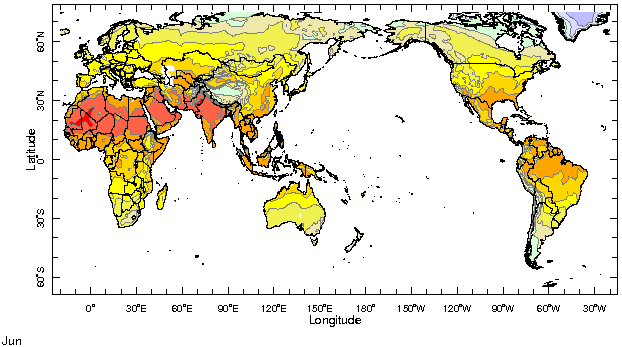|
IRI Climate Digest
July 2003
June Global Climate Summary
Climatological Background
In June, the sun's maximum northward location is achieved at 23.6 degrees north. Surface heating of the continents has initiated summer monsoonal systems or northern hemisphere warm season rains. In the Southern Hemisphere, winter is setting in with fewer daylight hours and cooler temperatures. The southern parts of South Africa, Australia, and South America are now in the path of mid latitude storm tracks.
Monthly Mean Temperature (1961-1990), data from the Climate Research
Unit, University of East Anglia


Monthly Mean Precipitation (1961-1990), data from the Climate Research
Unit, University of East Anglia


Temperatures
Highlights
A persistent long wave pattern in the northern latitudes of the eastern hemisphere brought a series of temperature anomalies to much of northern Asia and, most notably, southern and eastern Europe. Warmer-than-normal conditions were experienced in most of South America while the eastern half of the United States saw a cooler-than-normal June.
Temperature Difference from the 1961-1990 mean, with data
from NCEP Climate Prediction Center, CAMS.


Precipitation
Highlights
Drier-than-normal conditions dominated much of Europe due to the same atmospheric pattern that brought extreme warmth to the region during June. Above-normal precipitation in northwestern Asia can be attributed to the that pattern as well. China and portions of West Africa and Southern Asia saw wetter-than-normal starts to their climatological rainy seasons while much of southeastern Asia remained drier-than-normal. June also brought above-normal precipitation in northern Peru and the southeastern United States.
Precipitation Difference from 1961-1990 mean, with data
from NCEP Climate Prediction Center, CAMS-OPI.


Oceanic Conditions
Tropical Pacific: Monthly mean sea surface temperatures (SSTs) remained below normal in June in the eastern and central Pacific, but weekly observations indicated that SSTs crept closer to normal conditions during the course of the month. Slightly warmer than normal SSTs occupied a large region near and south of the equator and west of 150° west. See the latest IRI ENSO Update for a detailed summary and outlook.
Tropical Atlantic: SSTs in the tropical South Atlantic remained very much near normal in June. Warm SST anomalies in the Gulf of Mexico and Caribbean moved closer to normal in June, but warm anomalies intensified significantly further east and northward into the mid-latitudes.
Indian Ocean: Warmer than normal conditions intensified once again in the Indian Ocean after a slight moderation in May. The warmest temperatures continue to be found in the northern and western sections of the basin.
Mid-latitudes: The dramatic warming in the eastern North Atlantic, roughly along 30° north and northeastward toward Europe and Africa and into the Mediterranean was the most notable change in mid-latitude SSTs in June. The warmer-than-normal SSTs in the central South Atlantic moderated slightly, while temperatures increased along 40° south in the South Pacific west of 150°W.
Monthly Sea Surface Temperature Difference from the 1971-2000 mean,
with data from the Environmental Modeling Center, NCEP/NOAA.


Contents |
Special |
Impacts |
Climate |
Forecast
| 
